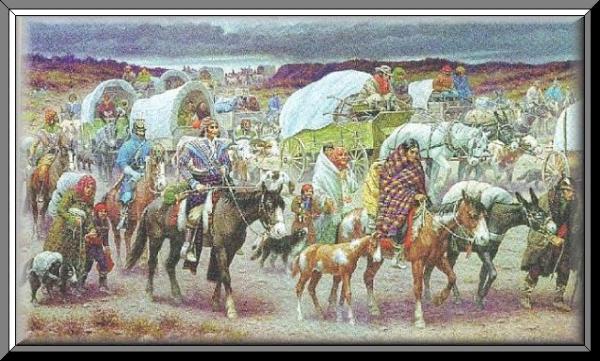
The Didactic Medium of Radio
In Jessica Abel's comic strip about radio, Ira Glass discusses the structure that every story on This American Life must follow in order to be successful. The story must be an anecdote where "this happened then this happened then this happened" and so on. The program, The Trail of Tears, which aired on This American Life, follows this structure as twin sisters Sarah and Amy Vowell travel the country in 5 days by car. During this trip they learn about and describe their ancestors' dreadful journey from Georgia to Northeast Oklahoma as well as reflect on each experience with their own feelings.

Throughout the program, Sarah and Amy's trip has been edited down to a series of anecdotes. The first focuses on what was the capital of the Cherokee Nation, Nuachota. To lead off this portion of the story, Sarah gives background information on the sequence of events which led to the building of Nuachota and then to the Cherokee's removal from Georgia to Oklahoma by Andrew Jackson.

Andrew Jackson
Following her description of events, Sarah follows Ira's model and has a time of reflection in which she shares her own feelings about what happened at Nuachota. She applauds the advances that the Cherokee made while also voicing her disgust in Andrew Jackson who she feels betrayed the United States Constitution when he went over the heads of the Supreme Court. It is here that Sarah comes to an unexpected conclusion Ira spoke about in that Andrew Jackson for the most part is seen favorably in the eyes of American history, but here Sarah is doing no less than accusing him of treason.
As Sarah and her sister continue on their journey, the program follows the same structure that it did in the beginning. In each instance where they reach a particular landmark, background is given followed by descriptions of what happened and reflection by Sarah and Amy. The scene at the high school in Arkansas shows Sarah in both a moment of disgust and acceptance of what she considers a great disrespect to the Cherokee. Here Ira's structure is followed as well as it has been previously throughout the program. Sarah recites the story of the memorial marker at a high school where Cherokee camped for a time and then proceeds to describe how the site is used by teenagers as an ashtray and hang out spot. Following the anecdote describing the situation, she expresses both her disgust and understanding that kids will be kids and they can't be blamed for not knowing better.
All during Sarah and Amy's journey, interesting stories continued to pop up and were relayed to the listener just as Ira described. What made the program interesting was both of the sisters' reflections on how they felt about each site. The program could've simply described the Trail of Tears giving facts and background information. What made the program engaging was the structure that it followed with Sarah and Amy Vowell, both part Cherokee, sharing their feelings along the Trail of Tears.
Site created by Matt Drosjack, e-mail at mattd@rice.edu